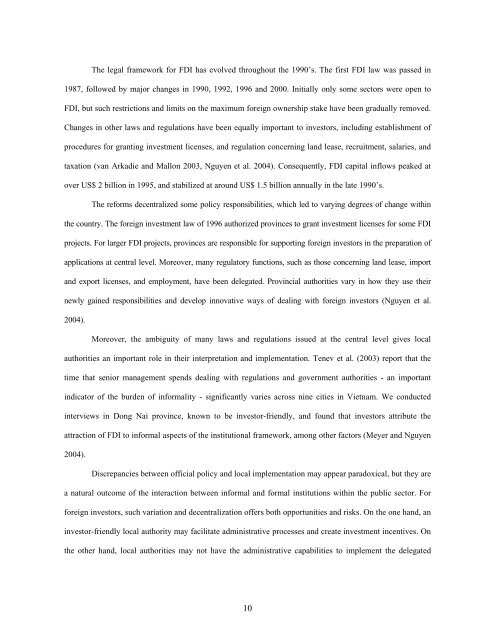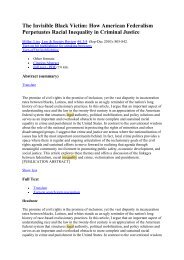Foreign Investment Strategies and Sub-national ... - E-Journal
Foreign Investment Strategies and Sub-national ... - E-Journal
Foreign Investment Strategies and Sub-national ... - E-Journal
You also want an ePaper? Increase the reach of your titles
YUMPU automatically turns print PDFs into web optimized ePapers that Google loves.
The legal framework for FDI has evolved throughout the 1990’s. The first FDI law was passed in<br />
1987, followed by major changes in 1990, 1992, 1996 <strong>and</strong> 2000. Initially only some sectors were open to<br />
FDI, but such restrictions <strong>and</strong> limits on the maximum foreign ownership stake have been gradually removed.<br />
Changes in other laws <strong>and</strong> regulations have been equally important to investors, including establishment of<br />
procedures for granting investment licenses, <strong>and</strong> regulation concerning l<strong>and</strong> lease, recruitment, salaries, <strong>and</strong><br />
taxation (van Arkadie <strong>and</strong> Mallon 2003, Nguyen et al. 2004). Consequently, FDI capital inflows peaked at<br />
over US$ 2 billion in 1995, <strong>and</strong> stabilized at around US$ 1.5 billion annually in the late 1990’s.<br />
The reforms decentralized some policy responsibilities, which led to varying degrees of change within<br />
the country. The foreign investment law of 1996 authorized provinces to grant investment licenses for some FDI<br />
projects. For larger FDI projects, provinces are responsible for supporting foreign investors in the preparation of<br />
applications at central level. Moreover, many regulatory functions, such as those concerning l<strong>and</strong> lease, import<br />
<strong>and</strong> export licenses, <strong>and</strong> employment, have been delegated. Provincial authorities vary in how they use their<br />
newly gained responsibilities <strong>and</strong> develop innovative ways of dealing with foreign investors (Nguyen et al.<br />
2004).<br />
Moreover, the ambiguity of many laws <strong>and</strong> regulations issued at the central level gives local<br />
authorities an important role in their interpretation <strong>and</strong> implementation. Tenev et al. (2003) report that the<br />
time that senior management spends dealing with regulations <strong>and</strong> government authorities - an important<br />
indicator of the burden of informality - significantly varies across nine cities in Vietnam. We conducted<br />
interviews in Dong Nai province, known to be investor-friendly, <strong>and</strong> found that investors attribute the<br />
attraction of FDI to informal aspects of the institutional framework, among other factors (Meyer <strong>and</strong> Nguyen<br />
2004).<br />
Discrepancies between official policy <strong>and</strong> local implementation may appear paradoxical, but they are<br />
a natural outcome of the interaction between informal <strong>and</strong> formal institutions within the public sector. For<br />
foreign investors, such variation <strong>and</strong> decentralization offers both opportunities <strong>and</strong> risks. On the one h<strong>and</strong>, an<br />
investor-friendly local authority may facilitate administrative processes <strong>and</strong> create investment incentives. On<br />
the other h<strong>and</strong>, local authorities may not have the administrative capabilities to implement the delegated<br />
10














